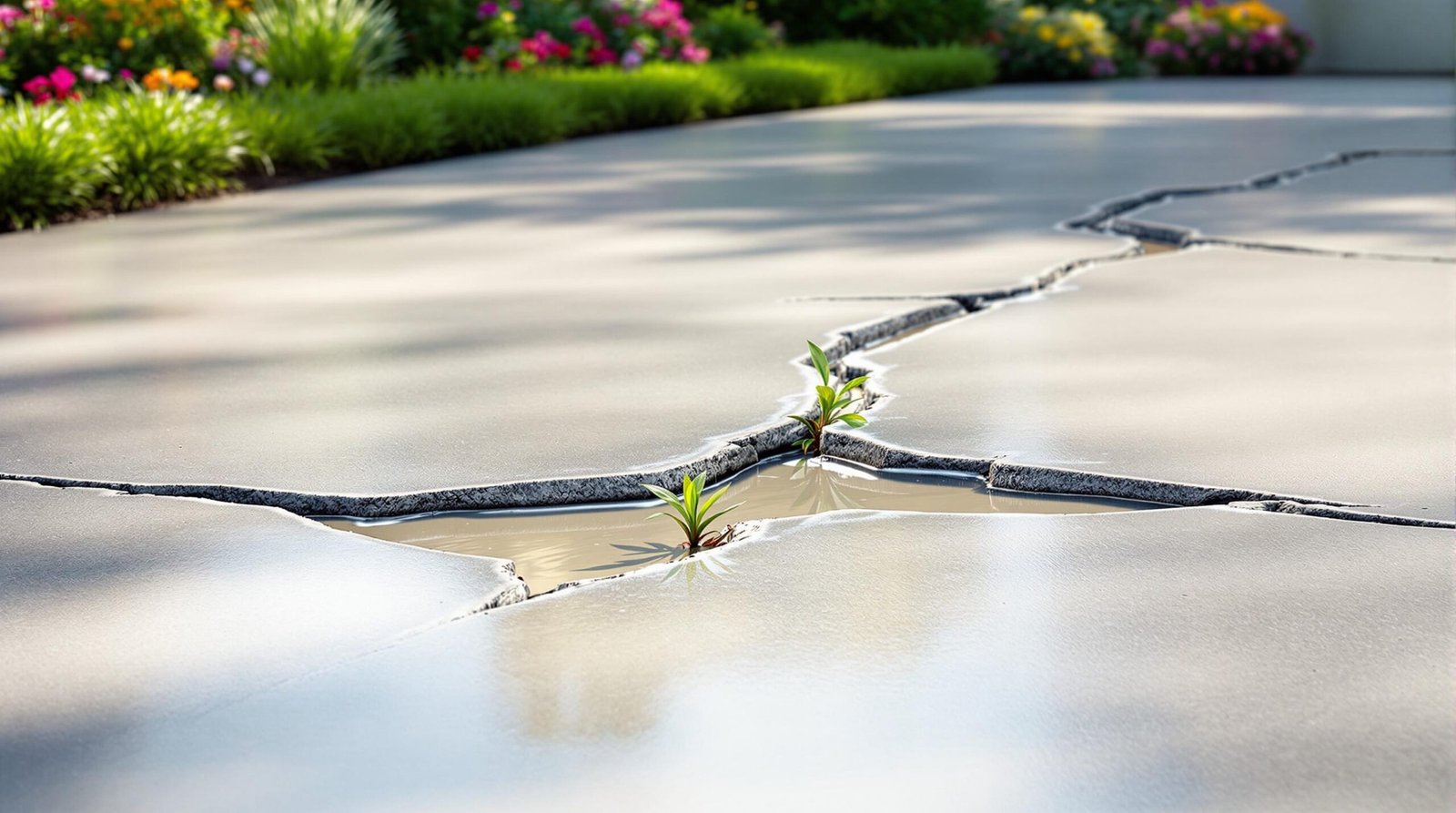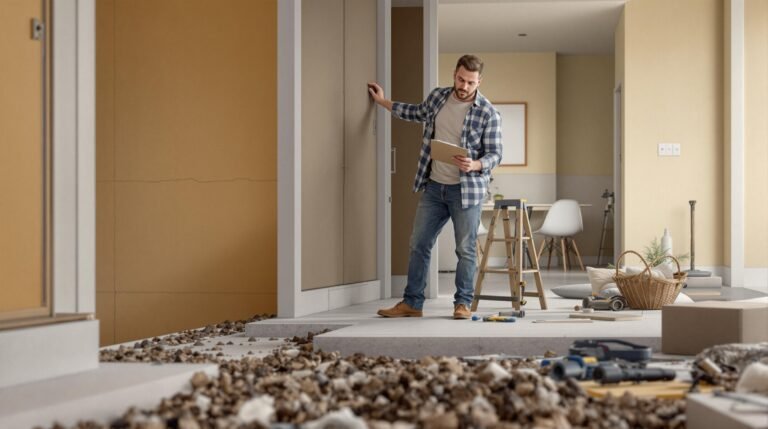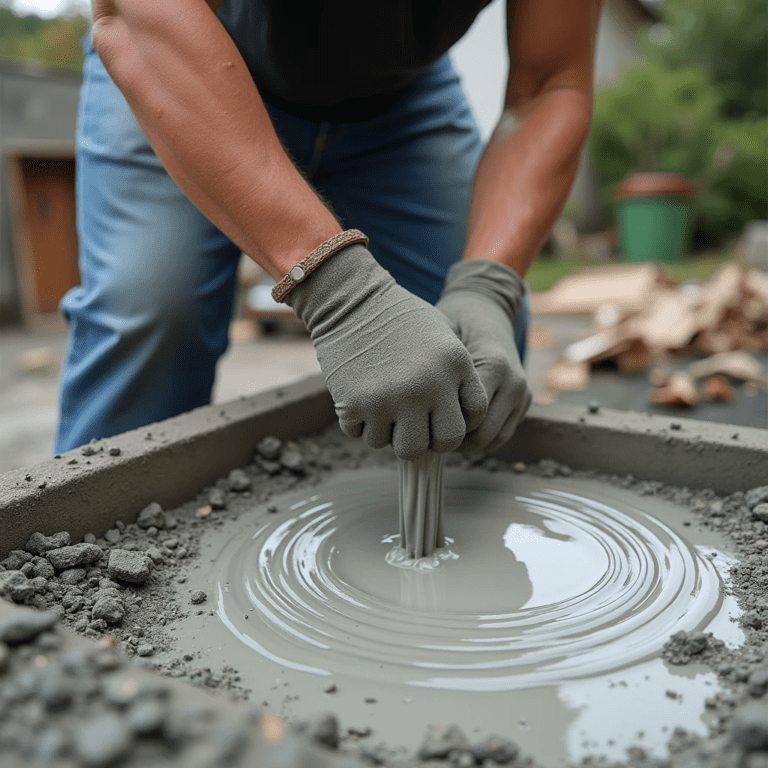24 Hours A Day 7 Days A Week

Concrete driveways can last over 30 years with proper care, but ignoring small issues can lead to costly repairs or even a full replacement. Here are 7 key signs your driveway needs professional attention:
- Cracks: Small cracks can grow due to water infiltration and freeze-thaw cycles. Cracks wider than ¼ inch indicate deeper structural problems.
- Sinking or Uneven Surfaces: Look for water pooling, gaps near your garage, or tilted sections – these often point to soil erosion or poor drainage.
- Poor Drainage: Standing water or runoff toward your home can weaken the foundation and lead to cracks or potholes.
- Surface Deterioration: Spalling, pitting, or discoloration are signs of wear caused by freeze-thaw cycles, chemicals, or moisture.
- Stains or Color Changes: Rust, efflorescence, or oil stains can signal trapped moisture, corroding reinforcements, or water damage.
- Joint Problems: Worn-out expansion joints or debris buildup can cause cracks and prevent proper concrete movement during temperature changes.
- Aging: If your driveway is 20+ years old and repairs are frequent, it may be time for a replacement.
Quick Repair Costs Overview:
| Repair Type | Cost Range |
|---|---|
| Crack Sealing | $100–$400 |
| Sinking Fix (Leveling) | $600–$1,200 |
| Major Repairs/Resurfacing | $600–$3,000 |
| Drainage Solutions (e.g., French drains) | $1,000–$18,000 |
Why Act Quickly?
Delaying repairs can lead to higher costs, safety risks (like trips or vehicle damage), and further structural damage. Professional contractors can address underlying issues, ensuring long-term durability and safety for your driveway.
If you notice any of these signs, don’t wait – get a professional evaluation to save money and avoid bigger problems later.
When to Repair or Replace Your Driveway
1. Cracks in Your Driveway
Cracks in your driveway might signal deeper structural issues that require attention. Let’s break down the common types of cracks and what they could mean.
Common Crack Types and Their Causes
The pattern and size of cracks can reveal what’s happening below the surface. Here are some typical crack types:
| Crack Type | Description | Likely Cause |
|---|---|---|
| Structural | Wider than ¼ inch | Foundation problems or heavy loads |
| Shrinkage | Spider web pattern | Poor concrete mix or improper curing |
| Heaving | Raised sections | Freeze-thaw cycles or tree roots |
| Settlement | Sunken areas | Soil issues or inadequate drainage |
Most residential driveways are designed to withstand pressures of 3,000 to 4,000 PSI. However, even with this durability, adverse conditions can still lead to cracking. As highlighted by AllAboutDriveways.com:
"When cracks develop, they should be sealed as soon as possible. Ultimately cracks should be sealed every year or as needed. Sealing the cracks will help to prevent further damage and failures like alligatoring and potholes."
How Cracks Worsen Over Time
Small cracks might seem harmless, but they can quickly escalate into serious problems due to several factors:
- Water Infiltration: Even tiny cracks allow water to seep in. During winter, this water freezes and expands, making cracks larger with each freeze-thaw cycle.
- Foundation Weakening: Water erodes the soil beneath the driveway, creating voids and uneven settlement. This weakens support and accelerates damage from regular traffic.
- Structural Damage: Cracks wider than ¼ inch often point to severe underlying issues. In such cases, sealing alone won’t suffice, and professional evaluation becomes necessary.
Paying attention to these signs early on can help prevent costly repairs down the road.
2. Sinking and Uneven Surfaces
Sinking surfaces often point to problems with the soil beneath. Whether caused by rainfall, poor drainage, or improper grading, water can erode the soil, leading to settlement and uneven surfaces.
How to Spot Uneven Areas
Here are some common indicators that your driveway might be sinking or uneven:
| Warning Sign | What to Look For | Potential Cause |
|---|---|---|
| Water Pooling | Standing water after it rains | Depressions in the surface |
| Visual Gaps | Gaps between the driveway and garage | Soil settlement |
| Surface Slopes | Tilted or dipped sections | Poor soil compaction |
| Edge Dropping | Lowered concrete edges | Erosion or settling |
These issues go beyond appearance – they can lead to practical problems and even safety concerns.
Risks to People and Cars
As noted by Groundworks, "A sunken driveway poses serious risks to personal safety, vehicle integrity, and even property value". Some of the key risks include:
- Vehicle Damage: Deep dips can scrape the underside of vehicles or throw off wheel alignment.
- Personal Injury: Uneven areas create tripping hazards, and pooled water can freeze in colder months, increasing the risk.
- Structural Problems: Sinking near your garage can interfere with door alignment and proper closure.
Repair Costs and Timing
Fixing these issues varies in price depending on the repair method:
- Concrete leveling: Costs around $4–$4.50 per square foot.
- Mudjacking: Approximately $14 per square foot.
- Polyurethane foam injection: Typically 20–50% pricier than traditional stone slurry leveling.
David Edens of Edens Structural Solutions highlights the importance of addressing these problems quickly: "Uneven, cracked concrete should therefore be seen as a significant safety hazard and addressed promptly". Repairs are often completed within 1–3 days, and the surface is usually ready for use within 24 hours.
3. Water Not Draining Properly
When water doesn’t drain properly, it can weaken your driveway’s structure and even damage its foundation over time. After heavy rain, take a moment to inspect your driveway for any signs of trouble.
Signs of Drainage Problems
Your driveway should have a slight slope – about 1/8 to 1/4 inch per foot – for proper water runoff. Here are some common red flags to watch for:
| Warning Sign | What to Look For | Why It Matters |
|---|---|---|
| Standing Water | Puddles after rain | Points to low spots or poor grading |
| Water Flow | Water heading toward your home’s foundation | Increases risk of basement flooding and foundation issues |
| Soil Erosion | Washed-away soil along driveway edges | Weakens the driveway’s support system |
These problems might seem minor at first, but ignoring them can lead to costly damage down the line.
Long-term Effects of Poor Drainage
Water can wreak havoc on concrete and asphalt driveways, especially in areas with freeze-thaw cycles. Paveman Pro emphasizes:
"Proper driveway drainage can prevent much of the damage that is caused by water, including the devastating effects of freeze and thaw cycles that deform asphalt".
If left unaddressed, drainage issues can lead to expensive repairs. Here’s what you might be looking at:
- French drains: $1,000–$18,000
- Channel drains: $3,000–$9,000 per 100 ft
- Driveway regrading: $1,500–$9,500
- Permeable pavers: $15–$60 per sq ft
Audie Brower, owner of JASB Roofing and Exterior Remodeling, warns:
"Poor driveway drainage can lead to water pooling, which not only creates a slip hazard but can also undermine the driveway’s foundation, leading to cracks and potholes."
Experts suggest solutions like channel drains for surface water, French drains for deeper water issues, or catch basins when municipal stormwater systems aren’t an option.
To stay ahead of these problems, inspect your driveway regularly after rain. If you notice pooling water or water flowing toward your home, it’s time to call a professional. Regular maintenance can save you from bigger headaches – and bigger bills – down the road.
sbb-itb-2aa6074
4. Surface Breaking Down
Concrete driveway surfaces often start to deteriorate in small, hard-to-notice ways before the problem escalates. Spotting these issues early can save you money and keep your driveway looking great.
Why Surfaces Break Down
Concrete driveways face wear and tear from various factors, which can lead to visible damage. Here are some common types of surface issues and their causes:
| Deterioration Type | Appearance | Common Causes |
|---|---|---|
| Spalling/Scaling | Surface peeling or breaking away | Freeze-thaw cycles and de-icing salts |
| Pitting | Small holes and depressions | Chemical exposure and poor finishing techniques |
| Flaking | Top layer chipping away | Moisture penetration and a weak surface |
| Discoloration | Uneven coloring or patches | Chemical reactions and water damage |
Spalling, for instance, not only affects the look of your driveway but can also create safety concerns, especially in areas with heavy foot or vehicle traffic. Research highlights that repeated freeze-thaw cycles, combined with de-icing salts, are key culprits in accelerating this damage.
Fixing Surface Damage Early
Catching and repairing surface damage early is critical. With proper care, a concrete driveway can last over 30 years. Ignoring issues, however, can drastically reduce its lifespan.
Experts at Concept Concrete stress the importance of maintenance, stating:
"Applying a quality sealer can stop contaminants from penetrating the concrete and help prolong the life of your driveway".
To address surface damage effectively, follow these steps:
- Immediate Assessment: Take photos to record the location and severity of the issue.
- Professional Evaluation: Consult a specialist to determine whether the damage is surface-level or indicates deeper problems.
- Protective Measures: Avoid using de-icing salts near damaged areas and redirect water to prevent further harm.
Regular upkeep, such as cleaning and sealing, can help prevent these issues from worsening. By staying proactive, you’ll protect your driveway and avoid more costly repairs down the line.
Next, explore how improper joint spacing can lead to even more structural challenges for your driveway.
5. Color Changes and Stains
Just like cracks or uneven surfaces, stains and color changes often signal deeper problems. Spotting these early can help you address the root cause before things get worse.
| Stain Type | Appearance | What It Suggests |
|---|---|---|
| Efflorescence | White powdery residue | Moisture carrying dissolved salts |
| Rust Stains | Brown or reddish marks | Corroding steel reinforcement |
| Dark Spots | Black or gray patches | Trapped moisture unable to evaporate |
| Oil/Grease | Dark irregular patches | Oil leaks from vehicles |
| Discoloration Patches | Uneven coloring | Water damage or improper curing |
Hiring a contractor to assess and fix these issues typically costs between $50 and $100 per hour. Let’s break down what these stains reveal about potential structural damage.
What Stains Reveal About Underlying Problems
Wagner Meters highlights the role of moisture in causing stains:
"Excess moisture doesn’t just evaporate; it takes your design with it. You can preserve your design and the concrete with proper moisture testing before stains and sealers are applied."
Here’s what different types of discoloration might mean:
- White Surface Deposits: These often point to moisture migration, which can weaken the structure over time.
- Dark Patches: Persistent dark spots suggest trapped moisture, which could lead to more serious structural issues.
- Uneven Coloring: This may result from inconsistent mixing, curing problems, or water damage caused by poor drainage.
Treating surface stains costs between $0.20 and $0.85 per square foot, while a full resurfacing job can range from $3 to $9 per square foot. Using a protective sealer can help prevent future stains and maintain the surface’s appearance. If stains persist, especially alongside other warning signs, it’s time to call in a professional.
6. Problems with Joint Spacing
Expansion joints are crucial for letting your driveway adjust to temperature shifts, reducing stress and preventing damage.
How to Check Joint Condition
Watch for these common joint issues:
| Joint Issue | What to Look For | Why It Matters |
|---|---|---|
| Gap Width | Uneven spacing or gaps closing up | Limits proper expansion |
| Joint Material | Worn-out or deteriorated filler | Allows water to seep in |
| Debris Build-up | Dirt, plants, or stones in the joints | Blocks movement |
| Edge Damage | Crumbling or spalling along joint edges | Signals joint wear and tear |
For best results, joints should be spaced at 30 times the slab thickness and cut to at least 1/4 of the slab depth. Regular maintenance is essential. As Texas Stone Sealers explains:
"A driveway expansion joint is a material used to fill the gaps between two concrete slabs or pieces to allow for expansion and contraction due to temperature changes. Without an expansion joint, pressure can build up, causing cracking and shifting in the driveway. It is important to install driveway expansion joints to protect the longevity of your concrete driveway and prevent costly repairs in the future."
Effects of Failed Joints
Concrete expands by about 0.0000055 inches per inch for every 1°F change. On a 100-foot driveway, this can add up to 0.66 inches of movement during a 100°F temperature swing.
When joints fail, you could face:
- Structural damage from water eroding the soil beneath
- Cracks spreading due to trapped pressure
- Safety risks like uneven surfaces or icy patches
If the joint material shows signs of failure, call a professional right away. Fixing the joints now is much cheaper than dealing with major concrete repairs later.
Next, learn how normal wear and tear can help you decide whether to repair or replace your driveway.
7. Normal Aging Signs
Concrete driveways naturally show signs of aging over time. Spotting these early can help you decide on the best maintenance approach.
How Long Driveways Last
On average, concrete driveways hold up for 20 to 30 years, though this varies based on climate and maintenance. Here’s a breakdown of how climate impacts longevity:
| Climate Type | Estimated Lifespan | Key Factors |
|---|---|---|
| Moderate Climate | 25–30 years | Proper drainage |
| Cold Climate | 20–25 years | Freeze-thaw cycles |
| Hot Climate | 25–30 years | UV exposure |
| Coastal Areas | 20–25 years | Salt air exposure |
Knowing your driveway’s age and its exposure to environmental factors can help you decide whether to repair or replace it.
Repair vs. Replace Decision
When to Repair:
- Cracks are less than ¼ inch wide
- Damage is limited to a small area
- Driveway is relatively new
- Surface imperfections can be addressed
When to Replace:
- Damage is widespread
- Driveway is 20 years old or more
- Repairs are becoming frequent and costly
Following these guidelines can help maintain your driveway’s safety and functionality. In more severe cases, it’s wise to seek a professional evaluation.
Boca Raton Concrete Co highlights:
"Maintaining the integrity and durability of your driveway requires that you understand the different types of cracks and the potential damage they can cause."
Quick repairs can add years to your driveway’s lifespan, but extensive damage often means replacement is the better choice. While asphalt driveways typically last around 15 years, concrete driveways – lasting up to 30 years – often prove to be a better long-term investment.
This information can help you decide when to bring in a professional for advice or repairs.
Conclusion: Getting Professional Help
If you’ve noticed any of the warning signs mentioned earlier, it’s time to bring in a professional. Experts have the tools and knowledge to address issues that DIY fixes just can’t handle.
A licensed and insured contractor doesn’t just patch things up – they dig into the root causes, whether it’s soil erosion, water damage, or heavy traffic. Plus, their work often comes with warranties, ensuring peace of mind.
"Concrete repair isn’t as simple as mixing some cement and applying it to a cracked surface. Proper repair requires an understanding of the property function and root causes of damage whether it’s due to soil erosion, poor installation, water damage, or heavy traffic." – Jess Sweetin, Author, LevelUp Concrete Solutions
How to Choose the Right Contractor
Once you decide to hire a contractor, make sure you choose wisely. Here’s what to keep in mind:
| Evaluation Criteria | What to Look For |
|---|---|
| Experience | Proven history with similar repairs |
| Credentials | Valid licensing and insurance |
| Estimates | Transparent cost breakdowns |
| Warranty | Clear terms and duration |
| Communication | Responsive and clear explanations |
Barrie Concrete Contractors is a great example of a company that ticks all these boxes. They use high-grade materials and modern techniques to ensure durable repairs. Their process includes:
- Detailed inspections to identify issues
- Tailored repair plans
- Professional-grade materials
- Expert installation
- Rigorous quality checks
"Customer satisfaction is our top priority, which is why we pay attention to every detail and work closely with you to understand your needs and create a customized solution that meets your unique requirements." – Barrie Concrete Contractors
While DIY fixes might seem like a quick and cheap solution, they often only cover up the problem, leading to even bigger issues later. Professional repairs may cost more upfront, but they address the real problems, saving you money in the long run.
Reach out to a qualified contractor to evaluate your driveway. Taking action now ensures your driveway remains safe, functional, and visually appealing for years to come.



